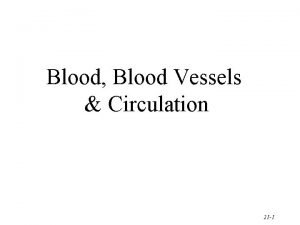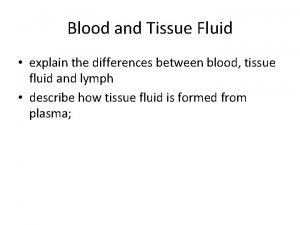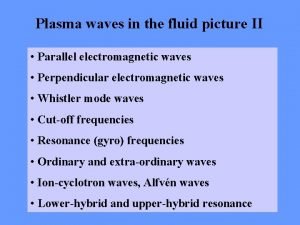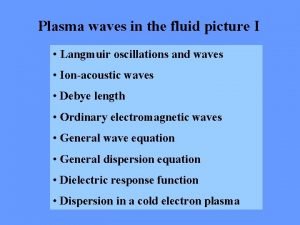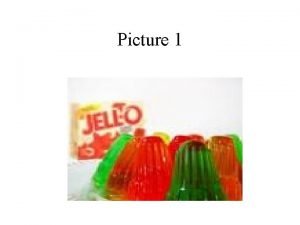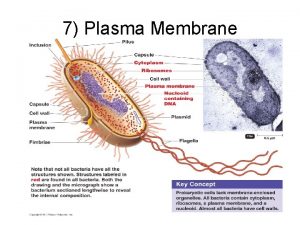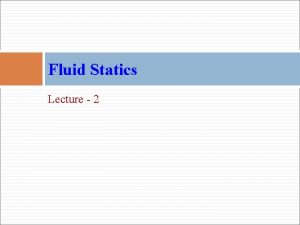Plasma waves in the fluid picture II Parallel






















- Slides: 22

Plasma waves in the fluid picture II • Parallel electromagnetic waves • Perpendicular electromagnetic waves • Whistler mode wavs • Cut-off frequencies • Resonance (gyro) frequencies • Ordinary and extra-ordinary waves • Ion-cyclotron waves, Alfvén waves • Lower-hybrid and upper-hybrid resonance

Parallel electromagnetic waves I We use the wave electromagnetic field components: They describe right-hand (R) and left-hand (L) polarized waves, as can be seen when considering the ratio This shows that the electric vector of the R-wave rotates in the positive while that of the L-wave in the negative y direction. The component transformation from Ex, y to ER, L does not change the perpendicular electric field vector. Using the unitary matrix, U, makes the dielectric tensor diagonal:

Parallel electromagnetic waves II The components read: The dispersion relation for the transverse R and L wave reads: The right-hand circularly polarised wave has the refractive index: This refractive index diverges for -> 0 as well as for -> ge, where k diverges. Here R, res = ge is the electron-cyclotron resonance frequency for the right-hand-polarised (RHP) parallel electromagnetic wave.

Parallel electromagnetic waves III Resonances indicate a complex interaction of waves with plasma particles. Here k -> means that the wavelength becomes at constant frequency very short, and the wave momentum large. This leads to violent effects on a particle‘s orbit, while resolving the microscopic scales. During this resonant interaction the waves may give or take energy from the particles leading to resonant absorption or amplification (growth) of wave energy. /kc 1/2 At low frequencies, << ge , the above dispersion simplifies to the electron Whistler mode, yielding the typical falling tone in a sonogram as shown above.

Whistlers in the magnetosphere of Uranus and Jupiter Wideband electric field spectra obtained by Voyager at Uranus on January 24, 1986. fc Whistlers Wave measurements made by Voyager I near the moon Io at a distance of 5. 8 RJ from Jupiter.

Whistler mode waves at an interplanetary shock Gurnett et al. , JGR 84, 541, 1979 w = ge(kc/ pe)2

Cut-off frequencies Setting the refractive index N for R-waves equal to zero, which means k = 0 at a finite , leads to a second-order equation with the roots: The left-hand circularly polarised wave has a refractive index given by: This refractive index does not diverge for -> ge and shows no cyclotron resonance. Moreover, since N 2 < 1 one has /k > c. The LHP waves have a low-frequency cut-off at

Refractive index for parallel R- and L-waves There is no wave propagation for N 2 < 0, regions which are called stop bands or domains where the waves are evanescent.

Dispersion branches for parallel R- and L-waves The dispersion branches are for a dense (left) and dilute (right) plasma. Note the tangents to all curves, indicating that the group velocity is always smaller than c. Note also that the R- and L-waves can not penetrate below their cutoff frequencies. The R-mode branches are separated by stop bands.

Perpendicular electromagnetic waves I The other limiting case is purely perpendicular propagation, which means, k = k. In a uniform plasma we may chose k to be in the xdirection. The cold plasma dispersion relation reduces to: Apparently, E decouples from, to E , and the third tensor element yields the dispersion of the ordinary mode, which is denoted as O-mode. It is transverse, is cut off at the local plasma frequency and obeys: The remaining dispersion relation is obtained by solving the two-dimensional determinant, which gives:

Perpendicular electromagnetic waves II When inserting the tensor elements one obtains after some algrabra (exercise!) the wave vector as a function of frequency in convenient form: Apparently, Ex is now coupled with Ey, and this mode thus mixes longitudinal and transverse components. Therefore it is called the extraordinary mode, which is denoted as X-mode. It is resonant at the upper-hybrid frequency: The lower-frequency branch of the X-mode goes in resonance at this upper-hybrid frequency, and from there on has a stop-band up to R, co.

Dispersion for perpendicular O- and X-waves The dispersion branches are for a dense (left) and dilute (right) plasma. Note the tangents to all curves, indicating that the group velocity is always smaller than c. Note that the O- and X-waves can not penetrate below the cut-off frequencies. The X-mode branches are separated by stop bands.

Frequency /Hz Frequency ranges of Z-, L-O- and R-X-mode waves Top: Dynamics Explorer DE-1 satellite orbit Left: Frequency ranges in the auroral region of the Earth magnetosphere Radial distance /RE Whistler and Z-mode waves are trapped.

Electric field fluctuation spectra in the auroral zone Measurements by the Dynamics Explorer DE-1 satellite in the Earth‘s high-latitude auroral zone. Maximal field strength at a few m. V/m. Wave excitation by fast electrons at relativistic cyclotron resonance. fp = 9 (ne/cm-3)1/2 [k. Hz] fg= 28 B/n. T [Hz]

Two-fluid plasma waves At low frequencies below and comparable to gi, the ion dynamics become important. Note that the ion contribution can be simply added to the electron one in the current and charge densities. The cold dielectric tensor is getting more involved. The elements read now: For parallel propagation, k = 0, the dispersion relation is: For perpendicular propagation, k = 0, the dispersion relation can be written as:

Ion-related dispersion effects The L-mode has a resonance at gi, the ion gyrofrequency. The refractive index N -> 0 at the slightly modified cut-off frequency, which includes ionic corrections. The low-frequency R-mode dispersion becomes now: The L-mode dispersion relation can be written analogously: Here L, res = gi is the ion-cyclotron resonance frequency for the left-hand-polarised (LHP) parallel electromagnetic wave. For very long (in the MHD regime) wavelength, k 2 < pi 2/c 2, both dispersion relations reduce to the simple Alfvén waves.

Lower-hybrid resonance For perpendicular propagation the dispersion relation can be written as: At extremely low frequencies, we have the limits: These are the dielectric constants for the X-mode waves. In that limit the refractive index is N = 1 , and the Alfvén wave dispersion results: For 1 -> 0 , the lower-hybrid resonance occurs at: It varies between the ion plasma and gyro frequency, and in dense plasma it is given by the geometric mean:

Waves at the lowerhybrid frequency Measurements of the AMPTE satellite in the plasmasphere of the Earth near 5 RE. Wave excitation by ion currents (modified two-stream instability). Ne 40 cm-3 Te several e. V lh/2 56 Hz Emax 0. 6 m. V/m

Low-frequency dispersion branches The dispersion branches are for a parallel (left) and perpendicular (right) propagation. Note the tangents to all curves, indicating that the group velocity is always smaller than c, and giving the Alfvén speed, v. A, for small k. Note that the Z-mode waves can not penetrate below the cut-off frequency L, co and is trapped below uh. The X-mode branches are separated by stop bands.

General oblique propagation The previous theory can be generalized to oblique propagation and to multiion plasmas. Following Appleton and Hartree, the cold plasma dispersion relation (with no spatial dispersion) in the magnetoionic theory can be written as a biquadratic in the refractive index, N 2 = (kc)2/ 2. The coefficients are given by the previous dielectric functions, and there is now an explicit dependence on the wave propagation angle, , with respect to B. The coefficient A must vanish at the resonance, N -> , which yields the angular dependence of the resonance frequency on the angle res as: The coefficient C must vanish at the cut off, N -> 0 , which means the cut-offs do not depend on .

Angular variation of the resonance frequencies The two resonance frequencies for a dense (left) and dilute (right) pure electron plasma, following from the biquadratic equation:

Drift waves The previous theory can be generalized to wave propagation in non-uniform media, in which the wavelengths are comparable to the natural scales in the plasma, such as the gradient scales: Ln = ln n -1; LB = ln B -1; LT = ln T -1 etc. New waves occur, drift modes, owing their existence to inhomogeneity. With the drift speed, ix = Ey/B 0 = -iky /B 0, the linearized 1 -D ion continuity equation is: Assuming quasineutrality and using Boltzmann‘s law: Using a plane wave ansatz, exp(-i t + ikyy), we obtain the small electron drift-wave frequency:
 Blood plasma and interstitial fluid
Blood plasma and interstitial fluid Tissue hydrostatic pressure
Tissue hydrostatic pressure Parts of a longitudinal wave
Parts of a longitudinal wave Longitudinal wave vs transverse wave
Longitudinal wave vs transverse wave An example for mechanical wave
An example for mechanical wave Mechanical waves and electromagnetic waves
Mechanical waves and electromagnetic waves The wave chapter 13
The wave chapter 13 Sound waves longitudinal waves
Sound waves longitudinal waves Long waves and short waves
Long waves and short waves Difference between matter waves and electromagnetic waves
Difference between matter waves and electromagnetic waves Mechanical vs electromagnetic waves
Mechanical vs electromagnetic waves Similarities of mechanical and electromagnetic waves
Similarities of mechanical and electromagnetic waves Surface waves and body waves
Surface waves and body waves Seismic waves are mechanical waves
Seismic waves are mechanical waves Compare and contrast p waves and s waves using venn diagram
Compare and contrast p waves and s waves using venn diagram Mechanical and electromagnetic waves
Mechanical and electromagnetic waves Aimtoknow
Aimtoknow Viscoseal
Viscoseal Fluid statics deals with fluid at rest
Fluid statics deals with fluid at rest Fluid statics deals with fluid at rest
Fluid statics deals with fluid at rest Total body water
Total body water Bioimpedância
Bioimpedância Hypoosmotic
Hypoosmotic
